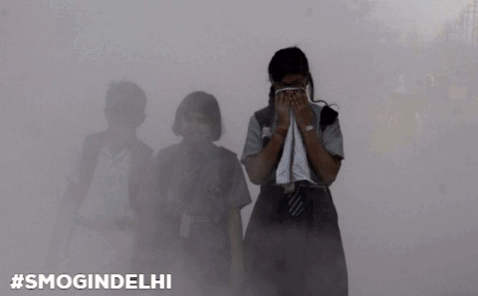New Delhi: When it comes to Air Pollution, Beijing and Delhi are two of the worst cities in the world, but the irony is that, the national capital on Tuesday beat Beijing and recorded 10 times more PM 2.5 – the deadliest, tiny particulate matter. According to the US Embassy’s air quality index, on Tuesday morning was above 600 in New Delhi, while in Beijing PM2.5 level was at 65. China and India, the world’s two most populous countries and account for half of the world’s pollution deaths. But, China is pushing the accelerator on anti-pollution measures.
In New Delhi, the pollution parameters from last couple of days are way above the permissible limits, to be exact; the levels are 42 times higher than the limits prescribed by the World Health Organisation (WHO) as ‘safe’.
The dense smog has been killing the capital; due to poor visibility over 20 vehicles collided on the Yamuna expressway resulting in injuries to at least 22 people. In hospitals, there was a spurt in fresh cases of patients with history of asthma, Chronic Obstructive Pulmonary Disorder (COPD) and cardiovascular diseases. AIIMS Director Randeep Guleria, who is also a renowned pulmonologist said “There is about 20 per cent rise in patients seeking treatment due to respiratory and cardiac issues.” While Vivek Nangia, Director and HOD, Pulmonology, Fortis, Lt Rajan Dhall Hospital, said that there has been a 25 per cent increase in OPD footfall of patients with various kinds of respiratory stress.
Watch: North India’s Health Emergency: AIIMS Director Speaks To NDTV
In a bid to take a control of the emergency situation, the Delhi government shut down the city schools till Sunday. The government has also announced the return of the odd-even road rationing scheme, version 3.0. Even the construction activities and entry of heavy vehicles like trucks have been stopped in the capital.
Also Read: Battling Delhi’s Killer Smog: Odd-Even 3.0 Returns From November 13, But Will It Be A Success?
But experts cite that these are just the temporary measures which are often taken after situation reaches an ‘emergency’ level under the Graded Plan of Action. These are not the permanent set of measures despite the fact that smog in the national capital is now an annual phenomenon.
Delhi, Take A Cue From Beijing
In 2013, when heavy smog dominated over one million square kilometres of Chinese territory between January 25 and 28, China introduced a four-tier warning system for severe weather conditions with red being the most serious, followed by orange, yellow and blue. If a city’s Air Quality Index (AQI) reaches 500 and if there are four consecutive days of heavy air pollution with AQI over 200, a red alert is issued in the city. During a “red alert” period a series of actions are taken immediately – even-odd road rationing formula is implemented; frequency of public transport like buses and subway trains is increased; schools and factories are closed.
The second level orange alert comes with the AQI of 400 and beyond; when this alert is passed then as a mandate the large-scale outdoor competitions and sports activities are stopped. Whereas the third level alert – yellow alert comes when AQI exceeds 300 and lasts for at least 24 hours. This alert halts the construction activities of sites that don’t meet a certain dust control standard along with ban on fireworks and the entry of heavy vehicles in the city.
The fourth alert – blue is the least severe and just the cautionary step which is triggered when AQI reaches over 200 and is expected to affect the air for less than 24 hours. In this case, all the outdoor activities such as physical education classes are shut down.
Apart from this, the authorities have also set up a ‘smog police’ in the city, that helps keep a tab on the violators of the regulations.
According to World Health Organisation (WHO), with these adequate steps to curb Air Pollution, PM2.5 concentration (annual) in Beijing has dropped to 85 micrograms/ cubic metre against Delhi’s 122 micrograms per cubic metre.































